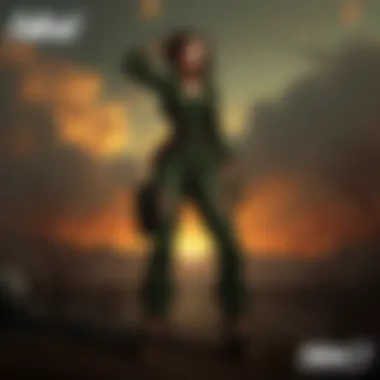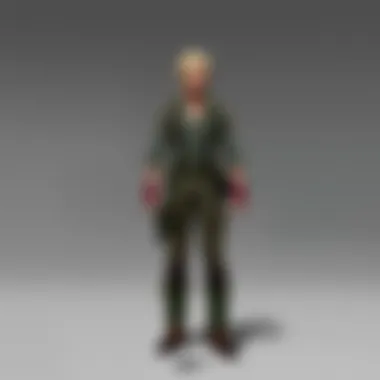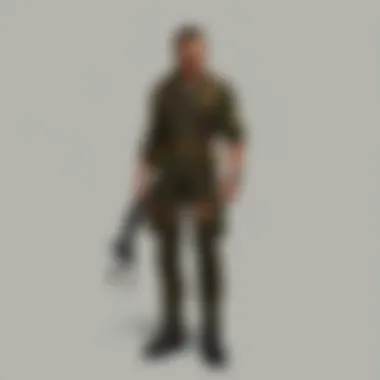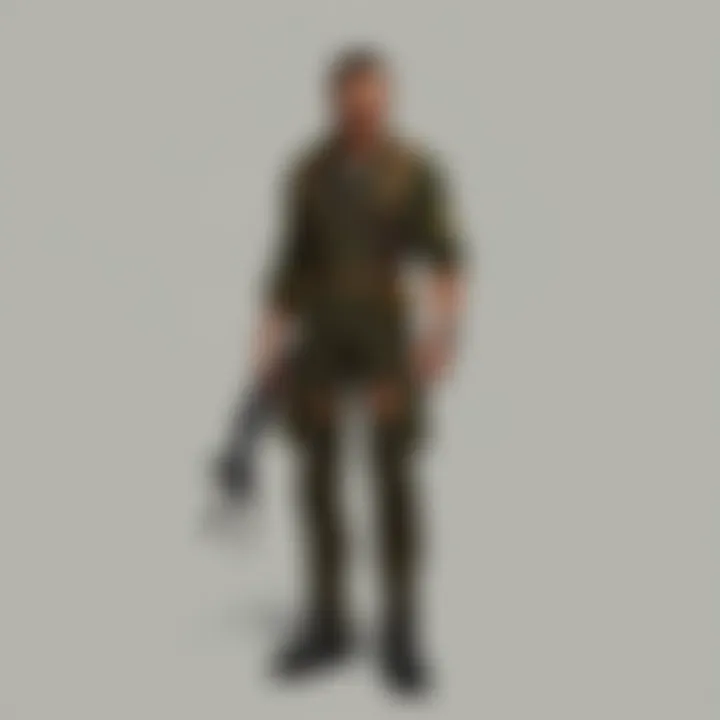The Ripped Jumpsuit: Fashion in Post-Apocalyptic Worlds


Intro
The notion of survival through fashion has seen an intriguing transformation in the worlds created by post-apocalyptic narratives. Among the various garments that have emerged from this genre, the ripped jumpsuit stands out with an emphatic presence. In settings ravaged by chaos, despair, and uncertainty, the jumpsuit transcends mere clothing; it morphs into a symbol of resilience and defiance.
As any fan of the Fallout series will tell you, the flipped risks of daily existence in these dystopian landscapes create not just a need for survival but a cultural tapestry woven with themes of identity. The jumpsuit, characterized by its versatile utility and distinct visual appeal, embodies the essence of what it means to navigate such a world.
In this article, we will embark on a journey examining the evolution of the ripped jumpsuit—from its origins to its role as a fashion statement within the backdrop of post-apocalyptic storytelling. By diving into the interplay of historical elements and game mechanics, we aim to highlight the significance of this garment beyond its fabric, emphasizing its relevance in connecting players to the narratives of survival and resilience that resonate throughout the genre.
Through the lens of the Fallout universe, we will dissect the lore, gameplay strategies, character arcs, and community narratives that collectively enrich the understanding of how ripped jumpsuits hold their own place in the annals of cultural symbolism.
Prologue to the Ripped Jumpsuit
The ripped jumpsuit has transcended its functional origins to evolve into a multifaceted symbol within the realm of post-apocalyptic aesthetics. This garment, once merely a practical attire for workers or mechanics, has woven its way into the narratives and visual landscapes of dystopian worlds, particularly in popular culture, video games, and fashion. The jumpsuit allows individuals to express not only a style but often embodies themes of survival and rebellion. As trends shift and society grapples with the unpredictable future, the ripped jumpsuit stands as a resilient beacon, reflecting the zeitgeist of a world grappling with change.
Historical Context
Understanding the historical context of the ripped jumpsuit is crucial to grasp its significance in both fashion and media. The jumpsuit's roots can be traced back to utilitarian clothing, particularly in the early to mid-20th century. Workers needing a practical garment for labor turned to one-piece outfits as they were durable and functional.
By the mid-1970s, the jumpsuit saw a wave of creativity as it was embraced by designers who brought it onto the fashion stage. Pieces began to appear, adorned with striking designs, colors, and materials to convey a bold statement. However, it was during the rise of the post-apocalyptic genre that the ripped jumpsuit truly found its niche.
In works such as the iconic Mad Max series, characters navigated a harsh, unforgiving environment while wearing dirtied, torn clothing—a representation of endurance through chaos. This laid the groundwork for the jumpsuit to be interpreted as a garment of resilience, resonating with audiences who found themselves in tumultuous times.
Symbolism in Fashion
The symbolism behind the ripped jumpsuit is intricate and layered. From a fashion perspective, this item represents a rebellion against the polished and perfect standards often set by traditional couture. Instead, it embraces an aesthetic of the rugged individualism and the beauty found in imperfection. The rips and tears tell a story of survival, suggesting a journey filled with challenges that cannot be hidden behind pristine fabric.
Moreover, in the context of post-apocalyptic narratives, the jumpsuit serves as both a literal and metaphorical armor. It signifies readiness for action, a refusal to yield to societal constraints, and an affirmation of personal identity amidst chaos. For gamers and fans immersed in worlds where every decision counts, the ripped jumpsuit becomes part of the narrative fabric, allowing players to wear their struggles and triumphs, visible in every frayed edge.
"In a world that’s ever-changing, the ripped jumpsuit stands resilient, reflecting our narratives of survival and identity in the face of adversity."
This garment's continuing evolution speaks to its ability to adapt to cultural shifts while remaining a steadfast representation of defiance and endurance. As the lines between fashion and identity blur, the ripped jumpsuit prominently stands at the intersection of style, symbolism, and survival.
Jumpsuits in Post-Apocalyptic Worlds
The incorporation of jumpsuits in post-apocalyptic narratives serves as a fascinating intersection of functionality and symbolism. In a world where survival hinges on adaptability and resourcefulness, clothing choices are not merely aesthetic but also deeply practical. The ripped jumpsuit, in particular, emerges as a crucial element, reflecting the harsh realities of life in a devastated world. Its role transcends mere fabric; it tells a story about identity, resilience, and the human condition amidst chaos.
The Role of Jumpsuits in Fallout
In the Fallout series, jumpsuits are iconic. Players encounter them right from the start, donned by the dwellers of Vaults designed to protect humanity. The familiar Vault Suit, predominantly blue with a striking yellow number, embodies several themes intrinsic to the game. It suggests protection against the unknown—both the physical threats of a ravaged environment and the psychological burdens of isolation.
When players step out into the Wasteland, the functionality of these jumpsuits becomes apparent. They provide a sense of basic armor against radiation, environmental hazards, and the marauding factions that inhabit the new world. The utility is paramount—pockets hold ammo and survival gear; the fabric is resistant to wear and tear, reflecting the harsh lifestyle of the survivors who wear them.
Moreover, the evolution of jumpsuits gameplay-wise reflects player choices and customization. Players often modify their suits with various upgrades or repurpose them, symbolizing adaptability in the face of dire circumstances. The aesthetic becomes a canvas for personal expression, showcasing the player's unique journey through a fractured society.
"In the stark expanses of the Wasteland, the jumpsuit is more than clothing; it's an emblem of hope, defiance, and survival."
Cinematic Representation
The cinematic portrayal of jumpsuits in post-apocalyptic films further enhances the garment’s significance. In movies like Mad Max or Children of Men, the ripped jumpsuit finds its narrative footing through the hands of characters who embody the struggle for survival. These representations often amplify the idea of rebellion against oppressive forces, whether they are tyrannical governments or mindless scavengers.
In Mad Max, for instance, the aesthetic of the jumpsuit is transformed from utilitarian to rebellious. Characters like Max Rockatansky wear their jumpsuits as badges of honor in the face of anarchy. The ragged edges symbolize both the weariness of battle and the spirit of those who refuse to crumble in adversity. This duality encapsulates the cultural essence of the jumpsuit as a robust choice, resonating with themes of defiance and resourcefulness.
Additionally, documentary-style footage featuring jumpsuits showcases their historical and cultural significance. By allowing audiences to see these styles through a lens of rugged authenticity, filmmakers portray them as artifacts of a culture that navigates catastrophe.
Through these varied representations, the jumpsuit evolves into a vessel of meaning, continually embodying the struggles and victories of humanity in dystopian realms. Truly, the worn fabric carries layers of narrative and emotion, leading to dynamic interpretations that resonate well beyond their physical form.
Design Characteristics of the Ripped Jumpsuit


When examining the ripped jumpsuit within the realm of post-apocalyptic aesthetics, one must consider its design characteristics, as these elements not only define the garment itself but also serve as markers of various themes reflecting survival and resilience. The design choices made in the crafting of the ripped jumpsuit carry significant resonance; they convey not just how the jumpsuit looks, but what it represents in the often grim narratives and settings found in post-apocalyptic media.
Material Choices
The fabric used in the construction of a ripped jumpsuit greatly impacts its overall appearance and functionality. Common materials include denim, canvas and even repurposed industrial textiles. Denim becomes a clear favorite for jumpsuits, thanks to its durability and inherent ruggedness. It wears well over time, weathering the rigors of a post-apocalyptic environment, both literally and metaphorically.
On the other hand, materials like canvas offer a bulkier, more protective option, appealing to those who might be navigating through treacherous terrains. Here, wear and tear are not simply flaws; instead, they become badges of honor, replicating the wearer's experiences and struggles.
- Cotton blends often add comfort and breathability, critical for survivalists.
- Synthetic fibers, while sometimes viewed as less authentic, bring in water resistance and adaptability, ensuring that a jumpsuit meets varying environmental conditions.
Material choices thus reflect a balance between practicality and aesthetic appeal, capable of standing against both the elements and the ceaseless challenges presented by a dystopian world. The textures and patterns emerging from these materials further contribute to the jumpsuit's rugged flair.
Color Palette
A careful look at the color palette reveals an underlying complexity in the representation of identity through garments. In post-apocalyptic aesthetics, the colors often trend toward muted and earth-toned hues, such as rusty reds, deep greens, and weathered grays.
These choices emerge from both practical and emotional considerations. Darker shades can mask dirt and wear, making them more functionally suitable for a world without modern comforts. However, the colors also evoke themes of decay and survival, reinforcing the narrative that the wearer struggles against a backdrop of chaos.
- Subdued tones like charcoal or olive suggest stealth and survivalism, critical for characters often depicted as scavengers.
- In contrast, faded metallic accents can suggest remnants of a once-vibrant society, hinting at a past filled with more color, thus deepening the emotional undertone of the garment.
i.e. the palette not only serves a practical purpose, it acts as a visual language that communicates the wearer’s story.
Functional Aspects
The allure of the ripped jumpsuit is significantly tied to its functional aspects, which take center stage in its design. In a world dictated by survival needs, every element of the jumpsuit serves a specific purpose.
First, the pockets become invaluable—large enough to hold weapons, tools, or scavenged items, they cater to a practical necessity. The highly ripped design allows for mobility, providing an ease of movement that’s crucial in any kind of fight or flight scenario. Zipper placements could allow for rapid access, ensuring characters can gear up or camouflage easily depending on their situation.
Moreover, ripped elements often function as a critique of consumer culture, celebrating DIY ethos and self-sufficiency. Keeping rips and tears visible can symbolize the resourcefulness of the wearer, underscoring the ability to adapt and overcome.
"Each rip tells a story of survival, embodying resilience while challenging the aesthetic norms of traditional fashion."
In sum, the design characteristics of the ripped jumpsuit are fundamental to its character and representation in post-apocalyptic contexts. They allow for a coherent narrative that weaves together elements of authenticity, resilience, and the brutal beauty of survival amidst chaos.
Cultural Significance and Interpretations
The ripped jumpsuit emerges not merely as a garment but as a beacon of expression, sentiment, and cultural commentary. Within the chaotic narratives of post-apocalyptic worlds, such as those depicted in video games like Fallout, its prominence signals discussions that reach beyond fabric and seams. This section aims to peel back the layers of the cultural significance tied to the ripped jumpsuit, highlighting its portrayal as a symbol of rebellion and resilience while offering insights into its deeper implications for identity and society.
Jumpsuits as Statements of Rebellion
The picture of the ripped jumpsuit in a dystopian landscape is steeped in defiance. This style emerges prominently as characters navigate the ruins of society, often garbed in tattered clothing that symbolizes their rejection of mainstream norms and values. The use of a jumpsuit in these settings conveys more than utility; it serves as an emblem of rebellion. It resonates with an anti-establishment sentiment, reflecting a choice to embrace the struggle rather than succumb to it.
In literature and games alike, we see how protagonists don these jumpsuits, showcasing their fierce individuality in speaks volumes. For instance, in games like Mad Max, characters wear gear that not only facilitates movement through harsh terrains but also gives a nod to resistance against oppressive forces. The slashes and tears in a jumpsuit can symbolize scars of survival or a sense of lost civility, making the clothing itself a canvas on which stories of defiance are painted.
Beyond the gaming realm, the jumpsuit mirrors contemporary movements. Fashion designers have taken cues from this grit, translating the essence of rebellion into streetwear. As such, each frayed edge tells of a choice to resist conformity and embrace authenticity. This type of apparel becomes a rallying cry for those identifying with misfits, as it underscores the notion that clothing can serve as an act of political and social protest.
"The jumped rip symbolizes more than just offhand fashion; it embodies narratives of struggle, identity, and the complexities of rebellion."
Resilience in Fashion Choices
In an era that often celebrates perfection and idealized aesthetics, the ripped jumpsuit stands as a testament to resilience and adaptation. In post-apocalyptic settings, characters frequently symbolize hope through their choices in fashion. The worn-out practicality of a jumpsuit paired with visible damage illustrates the ability to endure adversity. It embodies a philosophy where beauty lies within flaws, reflecting the ongoing struggle for survival amidst chaos.
When examining why individuals gravitate towards ripped jumpsuits, one finds hints at a collective consciousness yearning for authenticity. The motivations extend beyond mere fashion; it becomes a way to express acceptance of one's circumstances. Wearing a ripped jumpsuit elevates the wearer's experience from just living through chaos to thriving in it.
In modern contexts, the embrace of second-hand clothing and the rise of the DIY movement echo this sentiment. Individuals take pride in their worn and patched apparel, bridging the gap between past experiences and new realities. This approach aligns seamlessly with the notion of resourcefulness and ingenuity—traits necessary for navigating a post-apocalyptic landscape.
Ultimately, the cultural significance of the ripped jumpsuit transcends generations and media. It encapsulates both rebellion against societal norms and a celebration of resilience. By choosing this style, wearers declare their story, representing a life lived authentically and unapologetically, whether in a fictional world or the one they inhabit daily.


As this narrative unfolds, one can't help but reflect on how the ripped jumpsuit continues to mold perceptions within the labyrinth of post-apocalyptic aesthetics, offering insights into not just clothing but the human experience itself.
Fashion Trends Related to the Ripped Jumpsuit
The popularity of the ripped jumpsuit in post-apocalyptic aesthetics is not just a passing fad; it's a fascinating intertwining of fashion and cultural statements that reflect deeper themes. Examining the trends related to this garment sheds light on its broader significance and the way it has evolved within the realms of popular culture, particularly among the fans of post-apocalyptic narratives.
Influences from Streetwear
Streetwear has become a cornerstone of contemporary fashion, known for its casual approach and urban inspirations. The ripped jumpsuit draws heavy influences from this trend, as the style embodies a sense of laid-back resilience. The oversized, relaxed fits found in streetwear invite comfort and practicality, vital aspects of clothing choice in a dystopian setting. This functionality resonates with the themes found in games like Fallout, where survival requires both style and substance.
Moreover, the incorporation of bold graphics and logos in streetwear translates to the ripped jumpsuit through customization options. Players often seek ways to express their individuality, and the ripped jumpsuit serves as a blank canvas for creativity. Rips and alterations not only signify wear and tear but also act as personal markers, telling a story of the wearer's experiences within the apocalyptic landscape. Therefore, a jumpsuit with artistic tears can evoke a sense of belonging to a community that appreciates both fashion and survival.
Emergence in High Fashion
Interestingly, the ripped jumpsuit has also made its way into high fashion. Designers are increasingly captivated by the juxtaposition of elegance and decay. The aesthetic of ripping, fraying, and intentional wear mirrors the high-end brand's desire to play with concepts of beauty and imperfection. High fashion has a tendency to explore themes of dystopia, often seeking to challenge conventional notions of glamour.
Fashion shows have seen ripped jumpsuits gracing runways, adorned with avant-garde details that blur the lines of traditional attire. This crossover between gritty street style and polished couture indicates a cultural shift where fashion is no longer about pristine presentation but rather about representing resilience and authenticity.
Consider the influence of designers like Balenciaga or Vetements, who have embraced deconstruction in their collections. Their approach celebrates the aesthetics typically associated with survivalist fashion, making the jumpsuit invigorating ly relevant in both high and low fashion circles.
"Fashion is not just about clothes. It's about how those clothes tell a story and reflect the world around us."
Learn more about the evolution of fashion trends in various contexts.
Explore streetwear influences on modern style.
Discover high fashion's take on minimalism and decay.
The Ripped Jumpsuit in the Gaming Community
The ripped jumpsuit has transitioned from a niche representation of post-apocalyptic fashion to a cornerstone in the gaming community, especially among fans of survival narratives like those found in the Fallout series. This garment embodies a visual culture steeped in themes of struggle and resilience, capturing the spirit of characters navigating through ravaged landscapes. The relevance of the ripped jumpsuit transcends mere aesthetics; it represents player identity and customization while fostering a vibrant community through cosplay and shared interests. Let's delve into how this piece of clothing has become an essential element in gaming culture.
Player Customization Options
In modern gaming, particularly in titles like Fallout, player customization has become an integral part of the user experience. Ripped jumpsuits are prevalent in these games, offering a blank canvas for personal expression. Players can mix and match different styles, hailing from the diverse aesthetic choices each character can embody.
The importance of customization lies in its ability to allow players to reflect their individual style, as well as adapt characters to their gameplay strategies. Some players choose bright colors to stand out, while others might opt for darker, more muted tones to blend into the environment. Additionally, through various mods and downloadable content, players often have the option to create unique rips and tears that enhance the jumpsuit’s rugged appearance.
Customization options often include:
- Different fabric types, like denim or leather
- A selection of patterns and textures
- Customizable patches and insignias
- Various levels of wear and fade, which offer a personalized touch to each suit
As players explore and experiment with these options, the ripped jumpsuit becomes a dynamic representation of their achievements, style, and investment in the game.
Cosplay and Community Events
Cosplay has emerged as a vibrant aspect of gaming culture, bringing players together to celebrate their favorite characters and worlds. The ripped jumpsuit, due to its iconic presence in post-apocalyptic narratives, has found its way into many cosplay events and conventions. Fans channel their inner survivors by sporting these outfits, sometimes meticulously crafting them from scratch and other times modifying existing garments.
The appeal of cosplaying in a ripped jumpsuit lies in its versatility. It can be easily accessorized with makeshift weapons or survival gear, allowing enthusiasts to create visually captivating representations of their favorite characters. Engaging in cosplay not only showcases creativity; it also serves as a means of building community. Players connect over shared fandom, exchanging tips for construction and design, or simply reveling in discussions about the games.
"Dressing up as a character brings the game to life. It’s not just about the look; it’s about embodying the spirit of survival and resilience they represent."
Community events often feature competitions where the best-crafted outfits receive recognition, further motivating participants to push their creative boundaries. As the trend continues to grow, the ripped jumpsuit remains at the forefront, connecting players through a shared appreciation of gaming culture and post-apocalyptic aesthetics.
Sustainability and the Ripped Jumpsuit
As the world reckons with challenges like climate change and overconsumption, the conversation about sustainability in fashion has garnered considerable attention. It’s noteworthy how the ripped jumpsuit, once merely a style choice, has become intertwined with sustainable practices in the fashion landscape. This shift is particularly relevant for post-apocalyptic aesthetics, where the narrative often revolves around themes of survival, renewal, and resourcefulness.


The ripped jumpsuit stands as a representation of the means to adapt and transform in harsh environments, making it particularly attractive in post-apocalyptic narratives. Whether in a dystopian video game or a gritty film, clothing becomes a canvas to showcase resilience. In this context, the sustainability aspect of the garment fetches new significance.
Second-Hand Fashion Movement
The second-hand fashion movement underscores a pragmatic approach to sustainability. By recycling and reusing clothing, individuals can contribute to a more eco-friendly fashion ecosystem. The jumpsuit, with its utilitarian design and hardy fabrics, lends itself well to this approach. Here are some points to consider:
- Affordable Options: Many fans of post-apocalyptic aesthetics seek out second-hand stores that stock unique ripped jumpsuits. These garments often come with character, telling stories of their previous owners.
- Customization Potential: Second-hand pieces are perfect for personal touches. Enthusiasts often experiment with scissors, patches, or dyes, creating their own unique narratives within the fashion statement the jumpsuit provides.
- Environmental Impact: The waste from fast fashion contributes heavily to pollution. By choosing pre-owned clothing, consumers can reduce overall waste and minimize their environmental footprint.
Overall, the second-hand movement aligns perfectly with the themes central to the post-apocalyptic genre: survival, adaptation, and the reclamation of resources.
DIY Trends and Upcycling
The rise of DIY trends and upcycling offers another layer to this conversation. In a genre where ingenuity is often a survival skill, the ability to modify and enhance existing garments resonates well with audiences. Here are some insights on upcycling within the realm of the ripped jumpsuit:
- Personal Expression: DIY projects allow fans to create jumpsuits that mirror their personalities. From adding unique rips and embellishments to using fabric scraps for patches, the possibilities are endless.
- Creating Fashion Statements: Upcycled jumpsuits can transform a mundane piece into a bold statement. This process highlights individual creativity while promoting sustainable practices.
- Skills Acquisition: Engaging in DIY practices cultivates skills that can be invaluable in post-apocalyptic scenarios, where traditional resources may be scarce. Knowing how to sew or modify can empower individuals to better adapt to their environment.
"Sustainability is not just a trend; it's a movement towards a better future for the planet and its inhabitants. The ripped jumpsuit is a testament to that resilience."
Psychological Aspects of Clothing Choices
Clothing serves more than just the basic function of covering our bodies; it can also act as a canvas on which individuals paint their identities and experiences. This phenomenon is particularly pronounced in post-apocalyptic aesthetics, where garments such as ripped jumpsuits take on layered meanings. The psychological aspects of clothing choices become pivotal, influencing how wearers perceive themselves and how they are viewed by others. In a fragmented world, the ripped jumpsuit stands not just as a fashion statement but also as a symbol of survival and defiance.
Identity and Self-Expression
The choice to wear a ripped jumpsuit can hinge on deep currents of identity and self-expression. For Fallout players, these jumpsuits embody characteristics of resilience and grit, serving as a reflection of their in-game personas. The visual ruggedness inherent in these outfits allows players to project their gaming personas into their daily lives, merging the virtual with the real.
- Cultural Resonance: The jumpsuit echoes narratives of hardship, struggle, and triumph. Many wearers find that donning such garments expresses their unique stories, particularly in environments that may feel full of tedium or mundanity.
- Fleeting Trends, Lasting Impact: While streetwear trends come and go, the adoption of ripped jumpsuits signifies a deeper connection to identity, one that often resonates more than mere fabric choices. The act of choosing such a garment becomes an assertion of individuality amidst conformity, especially relevant in the thrumming waves of modernity.
- Rebel Aesthetic: Engaging with the rebel aesthetic that jumpsuits often evoke provides a sense of empowerment. Individuals may use clothing as a means to challenge societal norms, assert their distinctions, and create lines of division between themselves and those who do not resonate with the same spirit.
Through these facets of identity and self-expression, the ripped jumpsuit becomes a powerful part of an individual's narrative. Wearing such attire might help in aligning themselves with the fictional resilience of Fallout characters, crafting a story that extends beyond the bounds of the game.
Coping Mechanisms in Fashion
The psychological relationship between clothing choices and coping mechanisms is particularly nuanced. In the realm of fashion, wearing a ripped jumpsuit can offer several therapeutic benefits.
- Safe Haven: For many, their clothes act as armor, shielding them against external critiques and internal vulnerabilities. The rugged texture and rebellious cut of a jumpsuit can foster resilience, particularly when the world outside feels chaotic or overwhelming.
- Expression of Dissent: Adorning oneself in a ripped outfit can also signify a rejection of mainstream conventions. In turbulent times, such expressions become outlets for frustrations, fears, and aspirations.
- Tangible Connection: The tactile nature of clothing provides a sense of control. By choosing specific garments, individuals inject a piece of their will into their environment, grasping at agency in a world that can often feel devoid of it.
- Comfort in Familiarity: Nostalgia may also play a part in this relationship. Wearing a jumpsuit can trigger memories of gaming sessions or cherished world-building, offering emotional comfort while navigating a fragmented reality.
Ultimately, the psychological implications linked to clothing choices—particularly the ripped jumpsuit within a post-apocalyptic framework—paint a portrait rich in complexity. The jumpsuit is not merely a piece of clothing; it resonates with identity, serves as a lens for coping, and enhances the robustness of an individual's self-representation.
"Clothing serves not just as protection from the elements, but as an integral part of how we navigate the world, blending our identities with the stories we wish to tell."
For deeper exploration, visit sources such as Wikipedia on Clothing Psychology or check out insights from Psychology Today.
In the vivid tapestry of post-apocalyptic fashion, the ripped jumpsuit stands tall, weaving together threads of identity and resilience while serving as a poignant reminder of how the choices we make can offer solace, strength, and a means to narrate our life stories.
Finale: The Future of the Ripped Jumpsuit
The journey of the ripped jumpsuit within post-apocalyptic aesthetics suggests a complex interplay between fashion, identity, and cultural narratives. As we reflect on its evolution, it becomes apparent that the jumpsuit is not merely a clothing item but a profound symbol of resilience and defiance in the face of adversity. This article showcases how jumpsuits have morphed from utilitarian wear to bold statements in dystopian storytelling, particularly resonating with fans of titles like Fallout.
Evolving Trends
Looking ahead, the ripped jumpsuit seems poised to undergo further transformation. Several factors can drive these shifts:
- Material Innovation: With sustainability becoming paramount, eco-friendly fabrics will influence jumpsuit designs. Imagine jumpsuits made from organic cotton or recycled materials, fusing style with an ethical core.
- Customization: Personalization trends are on the rise. The jumpsuit may evolve into a blank canvas, where wearers can add patches, embroidery, or even LED embellishments, reflecting individual narratives or sentiments drawn from post-apocalyptic themes.
- Cross-Sector Influence: The integration of gaming culture, streetwear, and high fashion will continue to redefine the jumpsuit. Styles that once seemed niche could find mainstream acceptance, sparking new trends that embrace punk aesthetics while merging with modern interpretations of the dystopian wardrobe.
The adaptability of the jumpsuit as a canvas for expression allows it to remain relevant in ever-changing fashion landscapes. This will ensure its place not only within niche communities but also in everyday wear.
Potential in Future Media Representations
As our media evolves, the portrayal of ripped jumpsuits will likely shift to align with emerging societal narratives. Consider the following possibilities:
- Diverse Representation: Future media could depict a broader spectrum of characters wearing jumpsuits, representing various backgrounds and experiences. This inclusivity can further cement the jumpsuit as a universal symbol of survival.
- Narrative Depth: With video games and films increasingly focusing on character development and emotional storytelling, the jumpsuit could evolve as a narrative device, representing journey and growth. Filmmakers might utilize it to show how a character navigates their world—each rip and patch telling a part of their story.
- Cultural Commentary: As socio-political landscapes shift, the ripped jumpsuit may serve as a canvas for cultural critique. Filmmakers and game developers might use it to reflect or critique contemporary issues, making the jumpsuit a relevant symbol in storytelling.
"The ripped jumpsuit is not just fashion; it's a statement, a declaration of identity in a chaotic world."
By embracing these possibilities, the ripped jumpsuit can maintain its relevance and impact, proving to be a versatile garment that resonates deeply with the themes of survival and resilience woven throughout post-apocalyptic narratives. As fans and players continue to explore these worlds, the jumpsuit will remain a visual and symbolic anchor, embodying the struggle and hope of humanity amid desolation.







